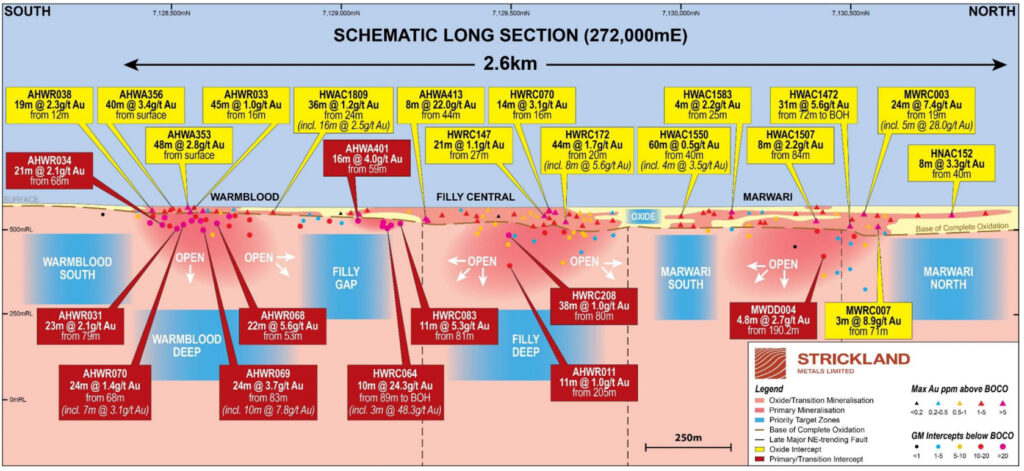‘Ideal geological setup for a major gold discovery’: Has Strickland solved the mystery of Marwari?
Mining
Mining
Special Report: Over the Christmas break successful WA gold hunter Strickland Metals defined a new 2.6km long trend at the flagship Yandal project. It is confident this corridor, between the Marwari and Warmblood prospects, could yield a major gold discovery.
Since June 2021, Strickland Metals (ASX:STK) has executed a series of acquisitions to consolidate the entire northeast flank of the prolific Yandal Greenstone belt in WA’s Goldfields region, about 50km north of Northern Star’s (ASX:NST) underground Jundee operation.
The project includes the 148,000oz Horse Well prospect, which despite significant historical drilling, is very poorly understood due to haphazard, patchy exploration work in the past.
STK — cashed up via its sale of its Millrose deposit to NST for $61m — kicked off a systematic 40,000m aircore drilling program at Yandal in early August.
Success came quickly with an impressive discovery at Marwari (31m @ 5.6g/t gold, ending in mineralisation). Subsequent success at Marwari and surrounding prospects ensured STK would be one of 2023’s top performing gold stocks.
Work over then Christmas break has now uncovered an impressive 2.6km coherent corridor of gold mineralisation extending from Marwari to Warmblood:

CEO Andrew Bray says this was the culmination of substantial work digesting the large drilling programs Strickland undertook in the second half of 2023.
“This corridor remains entirely untested in several large portions along strike, and largely untested at depth for almost the entirety of the prospect area,” he says.
“For example, only 7% of drilling has occurred below 150m, and only 3% below 200m depth.”
The company also believes it has solved the mystery of Marwari’s ‘complex’ mineralised structure. Like Millrose, thick high grade oxide gold hits were not initially replicated at depth due to barren cross-cutting structure.
“As an example, MRDD011 and MRDD012 at Millrose were drilled on a NE structure directly beneath impressive oxide intersections MSRC058: 35m @ 1.5g/t Au and MSRC067: 25m @ 2.7g.t Au,” Bray says.
“Both diamond holes returned highly altered and visually impressive, yet largely barren, intersections in the fresh rock.
“This same setting of NE cross-cutting structures was also observed north of Millrose at Wanamaker and again at Millrose South, with the same results (i.e. ‘blow out’ oxide results not being replicated at depth).
“Moving immediately along strike to the north and south of these NE structures, however, was where the main Millrose Mineral Resources were located.”
STK is now confident that this is what occurred with the initial Marwari drilling. What it means is the remainder of the 2.6km corridor represents “a very compelling exploration target”.
“It represents an ideal geological setup for a major gold discovery,” Bray says.
“High priority target areas include regions north and south of the NE-structure that dissects Marwari, including below an oxide intercept of 8m @ 3.3g/t Au from 40m (HNAC152) to the north and 60m @ 0.5g/t Au from 40m (HWAC1550) to the south.”
The company is currently relogging historic drill chips and conducting litho-geochemical analysis on this corridor, as well as the wider Horse Well area, to assist with further drill targeting.
“Once the wet season has finished, the company will begin systematically testing along the Marwari corridor, as well as other key areas in Horse Well identified from the 2023 drilling programs.”
This article was developed in collaboration with Strickland, a Stockhead advertiser at the time of publishing.
This article does not constitute financial product advice. You should consider obtaining independent advice before making any financial decisions.